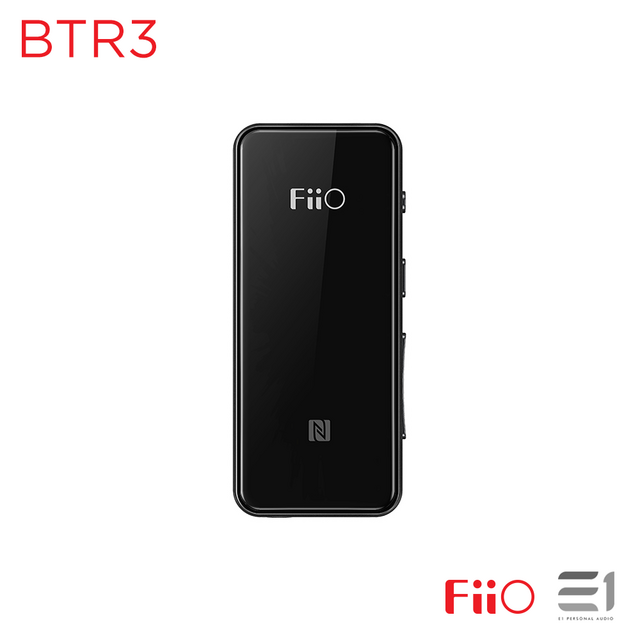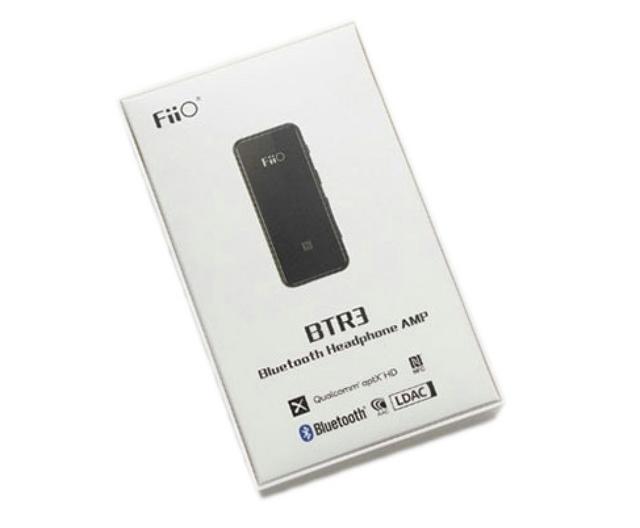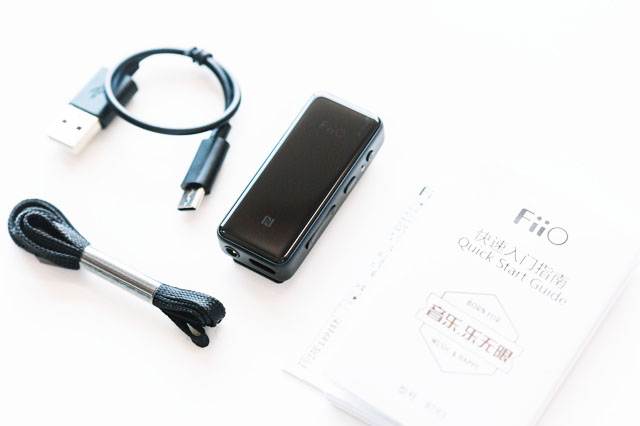Introduction
High resolution playback on smartphones is mostly restricted to flagship phones such as the LG V30S ThinQ and Samsung Galaxy S9 series which support MQA audio and Dolby Atmos respectably. Fortunately, with a 24-bit bluetooth receiver such as the BTR3 by FiiO you don't need the latest smartphone to enjoy high resolution audio on the go. The FiiO BTR3 is the company's latest and most advanced Bluetooth receiver, adding to FiiO's line of Bluetooth receivers which include BTR1 and μBTR. The FiiO BTR3 is the first Bluetooth receiver to support all the Bluetooth codecs available in the industry today, these include ACC, aptX, aptX HD, aptX LL, HWA, LDAC, and SBC.
Specifications.

Packaging & Contents
The FiiO BTR3 comes in a small white box with an image of the device on the front.
Inside the box are:
-FiiO BTR3 Bluetooth Receiver
-User manual and warranty
-Lanyard
-USB-C cable
A Closer Look
Measuring at 58mm x 25mm x 10.4mm (without clip-on), the BTR3 weighs in at 26g. The BTR3 is encased in an aluminum alloy shell with a 2.5D glass front panel. FiiO has added an oleophobic coating to the glass as well to save the device from smudges and fingerprints.
There's an LED on the front that lights up in different colours indicating various operating states and which Bluetooth codec is being used. The indicator can light up blue (SBC), cyan (AAC), purple (aptX and aptX-LL), red (charging), yellow (aptX-HD), white (LDAC) or green (LHDC) to indicate the input Bluetooth audio codec and charging status.
All the controls are on the right side of the device and are made up of 3 buttons in total. At the top is the Power on/off button that is also used to switch between input devices. In between the top 2 buttons is the built-in microphone which can be used for hands-free phone calls. The middle button is a multi-function button used for Reconnect/Play/Pause/Answer phone call/End call. It can also be used to force pairing mode and even to activate Siri for iPhone users. Talking about iPhone, the BTR3 bluetooth receiver works with both Android and iOS. The BTR3 features volume adjustment that is totally independent of that from the mobile phone as well as a battery system featuring a battery that's twice the capacity of the BTR1 and offering a longer battery life of 11 hours and a shorter charging time. Over on the back of the device is a metal clip which can be used to attach the BTR3 to clothing or a bag etc. At the top of the clip is a an opening which can be used to attach the included lanyard.
The USB port is for charging the unit. Incorporating the same AK4376A DAC chip as the M3K DAP, the BTR3 features a USB-C port which allows one to use the BTR3 as a USB DAC. The 3.5mm jack and USB-C port provide a very confident, snug fit. Don't have to worry about something snagging your earphone/headphone cable causing it to become unplugged. It is extremely secure!
Performance
The BTR3 can be simultaneously paired to 2 devices. I paired an iPhone 8 and an Astell&Kern AK70 simultaneously, and I could easily switch between the two, with the BTR3 smart enough to know which task I was performing on each device. For example, I could play music on the iPhone 8 via Bluetooth, then pause the iPhone 8 and immediately play music on the AK70. Playback on the BTR3 was nearly instantaneous, and if I was listening to the AK70 and pressed the iPhone's button to engage Siri, the AK70 paused and Siri would come through perfectly. When the BTR3 bluetooth receiver is connected to your smartphone, you can adjust both the phone's volume and the BTR3's volume but you get better sound output when keeping the phone at maximum volume and adjusting the volume level from the BTR3 bluetooth receiver. You can lock the audio output to avoid accidentally increasing the volume.
The BTR3 bluetooth receiver also comes with a companion app, called FiiO Music that you download to your smartphone. It is available for Android and iOS operating systems. Props should be given here to Fiio as the Android version looks almost identical to the iOS version, save for a few colour changes here and there, with the most notable being that the "Now Playing" screen has a dark theme on the Android version, and lighter theme on the iOS version. But other than that, the menu structure and location of buttons is the same. The most important feature is that the Fiio Music app will allow you to output your favorite music via your device's data-port into an external DAC device in bit-perfect condition. This means that every last bit of information contained in your music files will be sent to the external high quality device exactly the way they are stored in your device's memory without being altered in any way before reaching that external device. However, this does also assume that your Android device is actually capable of doing so, so it would be best to check if your device has USB Host mode. To install the beta app, simply download the FiiO Music Android App public beta version v0.0.8 from the FiiO website FiiO website and wait for the .APK package to download. Keep in mind that, because the app is not being downloaded from the Play Store, you may need to change the appropriate permission within your Android device's settings (often found either under security or developer options) first in order to allow "non-official" apps to be installed.
A sure selling point of the BTR3 is the fact that it supports Bluetooth streaming with both the aptX and aptX HD codecs. I tested the BTR3 with an iPhone 8 and Pioneer XDP-100R and Astell&Kern AK70 high-res digital audio players. The Pioneer XDP-100R supports near-CD-quality streaming with the aptX codec. The Pioneer visually confirmed an aptX connection when paired. The Astell&Kern AK70 is one of the few high-res audio players on the market that sports the better-than-CD-quality aptX HD codec. AptX HD can stream 24-bit/48kHz wirelessly. As soon as I paired the BTR3 with the AK70, the AK70 immediately registered an aptX HD connection.
With the BTR3, FiiO addressed one of the commonly cited criticisms of BTR1 being underpowered. While 24mW is not a lot of power, it is 60% higher than that of BTR1 and should suffice to power the earphones and IEMs that will be used with a Bluetooth receiver, which is designed for portability in the first place. While I used various headphone makes and models with the BTR3, I confined my reference listening to an Oppo PM-2 and Beyerdynamic Amiron Home. My comments below reflect listening sessions with those headphones. Through the Pioneer DAP, orchestral works, such as the Naxos 24-bit/192kHz high-res recording of Saint Saens Symphony No. 3 Organ maintained their space, depth, and instrument placement along the sound stage. Simply put, I was listening to each headphones qualities and signature sound, not the BTR3's imposed sonic coloration. What thoroughly impressed me about the BTR3 is how close wireless and wired performance was. Usually, wireless headphones sound very different between their wired and wireless modes. Playing any superbly recorded hi-res song by Chesky Records including Rebecca Pidgeon's Spanish Harlem, Alexis Cole's Dazzling Blue, or City of the Sun's Everything on the AK70 with aptX HD underscored the great potential that lies with the BTR3. Generally speaking, you'd be hard-pressed to tell the difference between the two modes. There was superb top-end extension, midrange clarity, and bottom-end response. Never in my wildest dreams did I think that I'd be able to get about 90-percent of the performance of high performance headphones in a wireless package. The biggest shortcoming between wired and wireless high-res playback, in my opinion, was midbass and bottom-end performance. Midbass and bass always sounded better, cleaner, and resolved more microdynamics when plugged in. Playing tracks like Underground Army or The Fire Rises from the 24-bit/192kHz version of the Dark Knight soundtrack made the differences immediately. However, on material such the DSD version of Pink Floyd's Wish You Were Here, the differences were more subtle and harder to make out.
FiiO's BTR3 has a rated battery life of 11 hours and this turned out to be quite accurate for me during use. Using the included USB-C cable the device can be fully charged in just 1.5 hours. You can also use the BTR3 DAC amplifier while charging. The BTR3 comes with a microphone so you can take calls without pulling out your phone. All the remote control options worked great. I made some calls using the BTR3 as well. People on the other end had no problem hearing me.
Final Thoughts
Most of the bluetooth receivers on the market seem to be cheap devices with loads of features, but absolutely awful sound quality. When using these devices with higher-quality earphones, it is almost painful to listen to. One particular problem that all these devices seem to have is an absolutely awful noise floor. This is NOT the case with the BTR3. If you have a compatible device, such as an Android Oreo phone, the LDAC function is revolutionary. It allows you to stream Hi-Res music files up to 24 bit 96khz. For such a small unit, it delivers a lot of up time up to 11 hours of continuous playback life from its 300mAh battery. The built quality is one of the best that I have seen for a Bluetooth receiver. The glass front with the pulsating status light is a nice touch. It also has a full aluminum body that is both lightweight and strong. The 58mm x 25mm x 10.4mm (without clip-on) BTR3 will slip into any pocket with ease, and a large clip on its back is designed to fasten the BTR3 to your clothing. The BTR3 will come with a companion iOS and Android app that will allow you to customize the receiver's sound and EQ settings, but FiiO wasn't able to provide access through Google Play Store for the app.
If you've made an investment in really good-sounding headphones and wondered when someone would invent a gadget to magically transform them into a wireless pair, then your wait is over. That day has arrived. I'm genuinely floored with how good the BTR3 sounded, especially when paired with high end headphones. For the first time, I didn't need to endure significant sonic compromises when I wanted wireless freedom. At the end of the day, the BTR3 won't completely cut the cord, but it will bring wireless freedom and hands-free calling to any headphones. And to do all this for an introductory price of $79.99 https://th.aliexpress.com/item/FiiO-...9d7b46869024-0
That makes the BTR3 go from audio accessory to audio essential.




















 Reply With Quote
Reply With Quote



Bookmarks